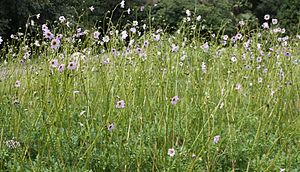Merck dahlia
| Merck dahlia | ||||||||||||
|---|---|---|---|---|---|---|---|---|---|---|---|---|

Merck dahlia ( Dahlia merckii ) |
||||||||||||
| Systematics | ||||||||||||
|
||||||||||||
| Scientific name | ||||||||||||
| Dahlia merckii | ||||||||||||
| Clay. |
The Merck dahlia ( Dahlia merckii ) is a species of the genus Dahlia ( Dahlia ) in the sunflower family (Asteraceae). It is named after the Hamburg senator and plant lover Heinrich Johann Merck (1770-1853).
features
The Merck dahlia is a perennial herbaceous plant with a rhizome and tuberous roots that reach heights of 40 to 90 centimeters. The plant is bare. The stem is richly and loosely branched from the bottom. The leaves are single to double pinnate. The leaflets measure 2 to 5 × 1 to 3 centimeters.
The numerous cup-shaped inflorescences have a diameter of 5 to 7 centimeters and are located on 5 to 30 centimeters long, branched stems. The outer bracts are linear. The ray florets are 2 to 3 centimeters long, colored white or light purple and have 3 teeth.
The flowering period extends from July to October.
The chromosome number is 2n = 36.
Occurrence
The Merck dahlia is found in Mexico from the states of San Luis Potosí to Guerrero and Veracruz .
use
The Merck dahlia is rarely used as an ornamental plant in borders and perennial beds. It has been in culture since 1840 at the latest.
literature
- Eckehart J. Jäger, Friedrich Ebel, Peter Hanelt, Gerd K. Müller (eds.): Rothmaler excursion flora from Germany. Volume 5: Herbaceous ornamental and useful plants . Spectrum Academic Publishing House, Berlin Heidelberg 2008, ISBN 978-3-8274-0918-8 .
Individual evidence
- ↑ Dahlia merckii at Tropicos.org. In: IPCN Chromosome Reports . Missouri Botanical Garden, St. Louis
- ^ Dahlia in the Germplasm Resources Information Network (GRIN), USDA , ARS , National Genetic Resources Program. National Germplasm Resources Laboratory, Beltsville, Maryland. Retrieved March 14, 2018.
